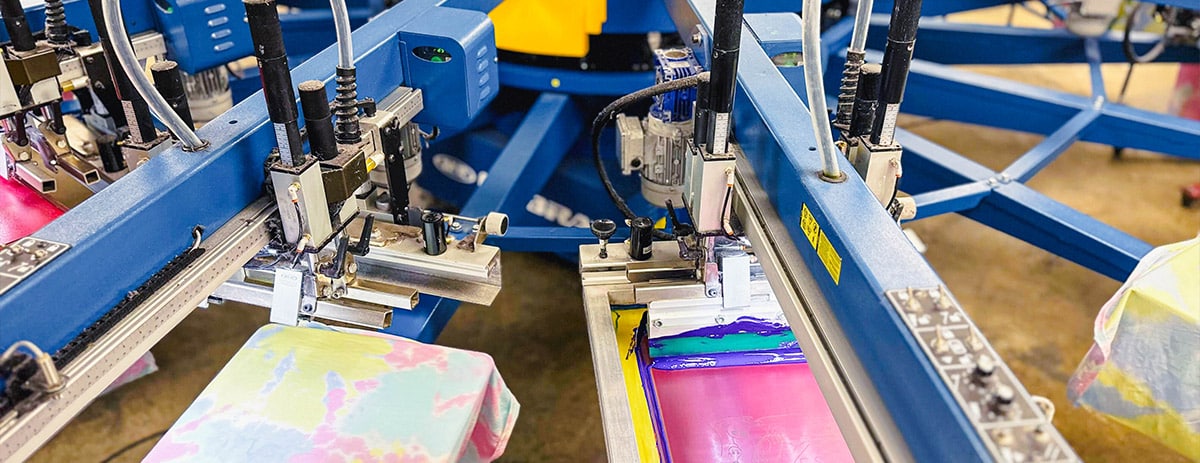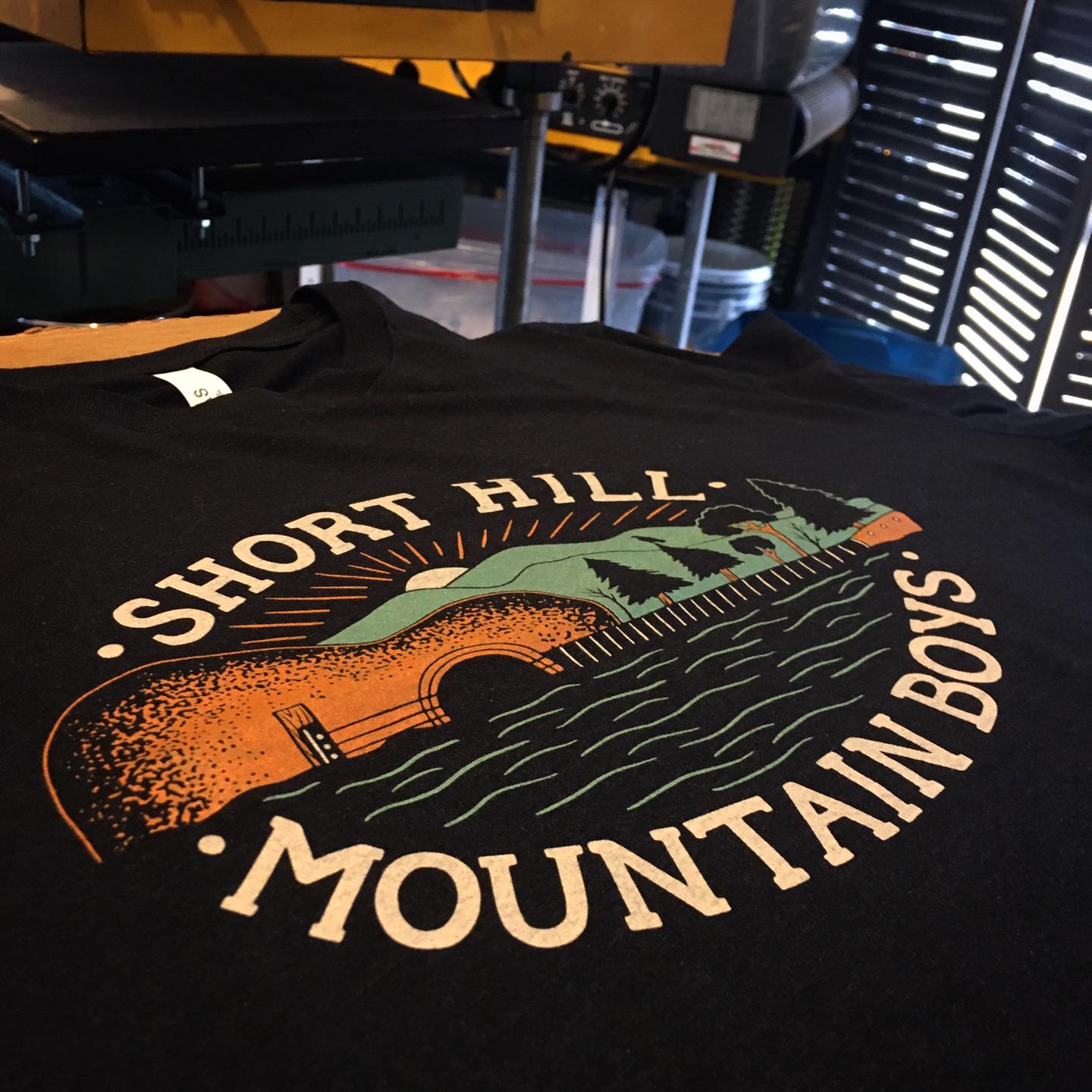Creative T-Shirt Printing Ideas for Small Brands
Creative T-Shirt Printing Ideas for Small Brands
Blog Article
Screen Printing Uncovered: Every Little Thing You Required to Know Regarding T-Shirt and Garment Printing Techniques
If you've ever questioned exactly how those dynamic layouts wind up on your favored tees, you remain in the appropriate place. Display printing is a remarkable approach that combines art with method, offering countless opportunities for imagination. Recognizing the fundamentals, from tools to ink selections, can substantially influence your outcomes. Prepared to check out the necessary aspects that make display printing an art type? Let's uncover the information that can boost your jobs.
The Fundamentals of Display Printing: Exactly How It Works
When you dive into display printing, you'll uncover it's both an art and a science. At its core, display printing involves developing a pattern, or screen, that enables ink to pass via only in particular locations.
Next, you'll mix your inks and prepare your printing surface area. Position the screen over the textile, then utilize a squeegee to press ink with the display onto the garment. This process needs accuracy, as you want clear, vivid prints. After printing, you'll cure the ink with heat, ensuring it adheres to the fabric and lasts through laundries. Each step is crucial, and understanding them will elevate your screen printing abilities, transforming basic garments right into special, expressive pieces.
Kinds of Display Printing Techniques
As soon as you grasp the essentials of screen printing, it's time to check out the different strategies that can elevate your layouts. One popular approach is typical screen printing, where ink is pressed through a stenciled screen.
One more choice is plastisol printing, known for its durability and vibrant shades, making it a favored for several brand names. Experiment with halftone printing to create gradient effects and elaborate styles.
Essential Devices for Display Printing
To accomplish spectacular lead to screen printing, having the best tools is fundamental. You'll require a strong display printing structure, which holds the mesh that moves your design onto the garment. Next, buy high-grade squeegees; these are crucial for applying ink uniformly throughout the display. You'll also need a good direct exposure device to develop your screens, as well as a washout cubicle for cleansing them after use. A trusted heat source, like a conveyor clothes dryer or warmth press, is vital for treating your prints to assure long life. Do not fail to remember an appropriate work space, geared up with tables and storage for your materials. Safety equipment, such as masks and handwear covers, will certainly maintain you secure from chemicals and inks. With the right devices, you'll be well on your method to producing professional-quality prints.
Picking the Right Inks and Materials
When choosing inks and products for screen printing, you require to take into consideration the sort of ink that works best for your project. Think of fabric compatibility to assure your designs look last and excellent lengthy. Explore green ink options to make your printing process a lot more lasting.
Kinds of Display Inks
Picking the right screen ink is crucial for achieving vivid, durable prints that fulfill your task's requirements. There are several kinds of display inks to check out. Plastisol ink is prominent for its adaptability and convenience of usage, supplying excellent shade opacity on dark textiles. Water-based ink, on the other hand, uses a softer feeling and is eco-friendly, making it suitable for those looking to decrease their ecological impact. Discharge inks get rid of color from the material, leading to a soft, classic appearance however need particular handling. Specialty inks, such as glow-in-the-dark or metal, can add one-of-a-kind effects to your layouts. Assess your project needs and pick the ink that lines up ideal with your desired end result.

Textile Compatibility Considerations
Comprehending textile compatibility is important for accomplishing high-grade display prints, particularly since different materials respond distinctly to various inks. When picking inks, consider the fabric kind-- cotton, polyester, or blends. For cotton, water-based inks function well, using softness and breathability. Polyester, on the other hand, typically needs plastisol inks for better bond and vivid shades. If you're printing on blends, you could require to use a mix of both kinds. Constantly test your inks on sample material to ensure they stick properly and keep color honesty. Additionally, remember that textile weight and structure can influence the last result, so picking the right ink and material combination is crucial for your project's success.
Eco-Friendly Ink Options
Green inks are becoming a prominent choice for screen printers who want to decrease their environmental effect while preserving quality. When choosing inks, consider water-based inks, which are less damaging and simpler to cleanse up contrasted to conventional solvents.
In addition, try to find inks made from renewable sources, such as soy or vegetable-based choices. By choosing the best inks and materials, you'll not only develop spectacular styles yet custom screen printing also add to a much more lasting printing procedure. Make the button, and your prints will reflect your commitment to the environment!
Preparing Your Layout for Screen Printing

Submit Layout Demands
To assure your style looks lively and sharp on textile, you'll need to pay attention to file style demands for display printing. Start with vector documents like AI or EPS, as they can be scaled without shedding top quality. If you use raster pictures, go with high-resolution documents, such as TIFF or PNG, preferably at 300 DPI. Prevent making use of JPEGs, as they can shed clarity when resized. Likewise, see to it your layout has a transparent history to protect against unwanted white edges on your prints. Maintain color modes in mind; CMYK is common for display printing, so convert your RGB makes accordingly - screen printing kit. By following these guidelines, you'll set your artwork up for a successful print.
Shade Splitting Up Techniques
Shade splitting up is an essential action in preparing your design for display printing, and understanding it can significantly enhance your print high quality. You'll need to damage your style into individual colors, as each color requires a different display during printing. Start by identifying all the shades in your style and create layers each. You can make use of software application like Adobe Photoshop or Illustrator to isolate and separate shades properly. Be specific to save each layer as a different data, normally in a format like TIFF or PSD. This accuracy not only assures accurate shade representation yet also simplifies the printing process. By paying interest to shade splitting up, you'll achieve professional and dynamic cause your screen-printed garments.
Resolution and Dimension
Accomplishing the most effective lead to display printing starts with guaranteeing your style has the right resolution and dimension. Preferably, your artwork must be at the very least 300 DPI (dots per inch) for sharp, clear prints. Your final product may look unprofessional and pixelated. if you make use of lower resolution.
When it concerns dimension, consider the dimensions of your print location. Style your artwork to match the final print size, ideally creating it in the actual measurements you'll be publishing. In this manner, you'll avoid any kind of unexpected scaling problems.
Constantly inspect your layout in both vector and raster layouts. Vector graphics can be scaled without losing high quality, making them ideal for display printing. Preparing properly will guarantee your design looks remarkable on every garment!
Step-by-Step Screen Printing Refine
Display printing is a dynamic procedure that enables you to produce vibrant layouts on different surfaces. To get going, you'll require a display, solution, and your picked ink. Prepare your display by cleansing it extensively. Next off, apply the solution uniformly and allow it completely dry in a dark location. Once completely dry, expose your screen to light with your layout positioned on it, which will harden the solution where the light hits, creating a pattern - screen printing kit.
Pour ink onto the display and use a squeegee to press the ink with the stencil onto the textile. Lift the display meticulously and let the print completely dry. You have actually successfully screen printed your layout.
Tips for Effective Display Printing Projects
While you're diving right into your display printing tasks, bear in mind that preparation is crucial to success. Begin by collecting all your products-- inks, screens, squeegees, and garments. A tidy work space aids stop undesirable errors, so clean up prior to you start.
Next, verify your artwork is high-resolution and properly sized for your garment. Check your screen for appropriate direct exposure and clean it completely to avoid smudges. When blending your inks, follow the supplier's standards to accomplish the right consistency.
Throughout printing, apply also stress with your squeegee for consistent outcomes. Do not rush; take your time to validate each print fulfills your criteria. After printing, allow your garments dry completely prior to handling or packaging them.
Lastly, constantly maintain an example of your benefit future referral. This means, you can examine your progress and boost your techniques gradually. Happy printing!

Often Asked Concerns
For how long Does It Require To Set up a Display Printing Task?
Establishing up a display printing job normally takes about thirty minutes to an hour. You'll prepare the screens, mix inks, and readjust journalism. The time varies based upon intricacy and experience, so stay arranged!
Can I Publish on Various Textile Types Making Use Of the Same Technique?
Yes, you can publish on different textile types utilizing the same method, yet you'll need to adjust your settings and inks. Some materials absorb ink in different ways, so experimenting warranties the very best results for every product.
What Prevail Blunders to Prevent in Screen Printing?
When screen printing, stay clear of common errors like using the incorrect ink, neglecting correct direct exposure times, or missing pre-press checks. Always examine your arrangement and maintain clean screens to ensure top quality results each time.
Exactly How Can I Properly Clean and Maintain My Display Printing Tools?
To appropriately clean and preserve your display printing devices, you should consistently clean screens with ideal solvents, examine mops for wear, and ensure all tools are saved dry and dust-free. Consistency boosts and prevents pricey repairs efficiency.
Is Display Printing Eco-friendly Contrasted to Various Other Methods?
Screen printing can be a lot more eco-friendly than other methods, especially if you make use of eco-conscious materials and water-based inks. By picking sustainable products and techniques, you reduce waste and minimize your influence on the world.
Screen Printing Uncovered: Every Little Thing You Required to Know Regarding Tee and Garment Printing Methods
At its core, display printing includes creating a stencil, or screen, that permits ink to pass with just in particular locations. Setting the screen over the textile, then utilize a squeegee to push ink via the display onto the garment. One preferred technique is typical screen printing, where ink is pressed through a stenciled screen.When selecting inks and products for display printing, you require to take right into account the type of ink that works finest for your task.
Report this page